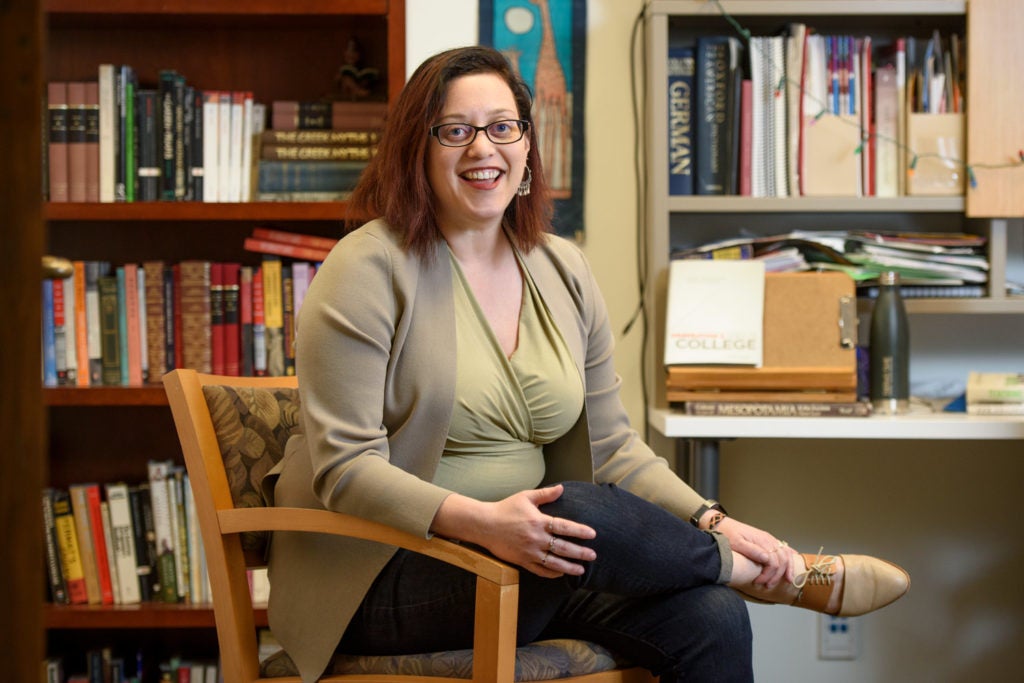Newcomer Guides added to the undergraduate advising mix

Starting this year, incoming Stanford students have been matched with Stanford Newcomer Guides, who are faculty and staff volunteers who mentor between four and eight undergraduates from the time they arrive on campus until they declare a major.
The program is designed to complement and support the academic advising students receive from professional staff within the Undergraduate Advising and Research (UAR) office over the course of all four years.
Alice Petty, director of pre-major advising, talks about the Stanford Newcomer Guides, about how the program is working so far and about undergraduate advising in general at Stanford.
Why were the new undergraduate mentors given the name “Newcomer Guides?”
The name pays homage to a revered university mentor—alumna Mabel Newcomer, who earned both her bachelor’s and master’s degrees from Stanford. She was the daughter of early Stanford English Professor Alphonso Newcomer, and she later served as a professor of economics for 40 years. She was well regarded for the value she placed on mentoring and empowering undergraduate women. So, the name is a nice tip of the hat to a bit of Stanford history.
How would you describe the new mentorship program for incoming students?
The Newcomer Guides are a community of faculty and staff volunteers who commit to welcoming our students and supporting them through their transition to college and their declaration of a major. That support looks different depending on the needs of the student and, of course, the guide’s mentoring style, experience and personality.
Some guides are casual and friendly, and some are more formal. Some approach their mentoring from a coaching perspective, or as a sounding board, or through the lens of their teaching. And, of course, many of our guides are parents of high school or college students.
We strive to connect students with resources that help them thrive, and with opportunities well suited to their individual interests and goals. The best way to do that is to get to know the student. Newcomer Guides engage in an ongoing conversation with their students about things like weighing competing options, identifying interests and values, wellness, reflection, resilience and the integration of academic and co-curricular experiences into a coherent whole.
How is the program working so far?
It’s a little early to say, but so far so good! We are doing some great training workshops for the guides on things like helping frosh and undeclared sophomores incorporate research, professional development or service into their Stanford plans. Next quarter we’ll be focusing on student wellness, including strategies for promoting self-care and stress management, connecting students with academic support resources and talking with students about academic integrity
I’m especially excited because the training workshops for the guides are now largely taught and run by the guides themselves. Our community of Newcomer Guides includes experts on things like academic skills resources, professional development, service, wellness and academic-skills coaching, as well as exceptional researchers and teaching faculty from throughout the university. That means that when students pursue these resources and opportunities, they are likely to encounter someone who is a part of this network of engaged, caring and informed volunteers.
How does the work of the Stanford Newcomer Guides complement and support that of the academic advising students receive from professional staff within the Undergraduate Advising and Research office?
The Newcomer Guides are an important part of the network of support and encouragement that our office strives to provide for our students. The fact of the matter is, academic success is a part of a bigger picture, one that includes balance, wellness, support, reflection and inspiration. Because guides can really get to know their two to eight students, they are often the first ones to know when a student needs help or is well-suited for a particular opportunity. So they can serve as a resource for the student, as well as a bridge to our professional advising staff.
What advising is available to upperclass students even after they have chosen a major and been assigned a faculty advisor?
Each and every Stanford student has an academic advising director, assigned to them based on where they reside a given year, although our policy is that any student can see any UAR advisor. Our advising staff also includes Academic Advisors for Student-Athletes, pre-professional advisors who work with students who want to apply to medical school or law school or who are interested in careers in business or education and an advisor who specializes in advising undergraduate students pursuing co-terminal degrees.
UAR advisors are able to answer complex questions about the curriculum, degree conferral, general education requirements, honors and research. They support students in academic distress and students taking—or returning from—a leave of absence.
UAR is also the office that dispenses money for research, and our advisors work with students on applying for research grants. UAR partners with offices across the university, including the Office of Accessible Education, the Bechtel International Center and the Haas Center for Public Service. UAR is also the place where upperclass students interested in competitive scholarships for graduate school can learn more.
What advice do you have for parents and guardians seeking to help their students navigate Stanford’s many academic options?
Encourage your students to use advising! Advisors can help students who are in academic distress, but we also help students thrive by helping them take their success to the next level.
We know so much about what Stanford has to offer, and we can help students find the special opportunities, classes, programs, people and experiences that can make their Stanford experience extraordinary. We are great resources for students struggling to decide on a major, and we love connecting students with faculty.
